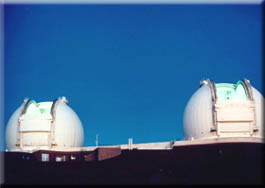Astronomers Find that the Cosmic Laws Are Changing With Time
(Clearwisdom.net) According to reports from the New York Times on August 15, 2001, an international team of astrophysicists has discovered that the basic laws of nature as understood today may be changing slightly as the universe ages, a surprising finding that could rewrite physics textbooks and challenge fundamental assumptions about the workings of the cosmos.

Keck telescope: the largest optical telescope and the Near InfraRed Camera(NIRC)
The researchers used the world's largest single telescope to study the behavior of metallic atoms in gas clouds as far away from Earth as 12 billion light years. The observations revealed patterns of light absorption that the team could not explain without assuming a change in a basic constant of nature involving the strength of the attraction between electrically charged particles.
If confirmed, the finding could mean that other constants regarded as immutable, like the speed of light, might also have changed over the history of the cosmos.
Even scientists on the project have been deliberately cautious in presenting their results. Describing the implications of what his team observed, Dr. Webb said, "It's possible that there is a time evolution of the laws of physics."
Dr. Rocky Kolb, an astrophysicist at the Fermi National Accelerator Laboratory who was not involved in the work, said the finding could not only force revisions in cosmology-- the science of how the universe began and later evolved--but also add credence to an unproven theory of physics called "string theory," which predicts that extra dimensions exist.
The observations, made by the 30- foot-wide Keck Telescope on Mauna Kea, in Hawaii, looked in detail at the absorption of quasar light by gas clouds in deep space between Earth and the quasars. Metal atoms like zinc and aluminum are often present in trace amounts in the clouds.
The absorption of light by such atoms creates dark spikes at various wavelengths in the quasar's spectrum, with a pattern so well defined that it is often likened to a fingerprint. The value of those wavelengths is directly related to the value of the fine structure constant.
But the fingerprint seemed to change in time, Mr. Murphy said, indicating that the constant grows larger as one goes nearer to the present and was not really constant. Researchers pointed out that the physical laws may be changing with time.